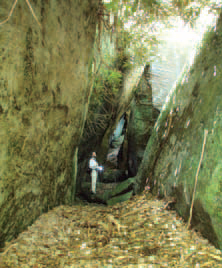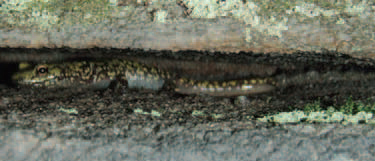Field Notes: Denizens of Hidden "Rock Cities"
by Charles Bier
Suddenly there was a buzz-hissing sound projecting out of a large crevice in the cliff face immediately in front of us. Instinctively, my colleague and I froze in place and stepped back. It was the sound of one or more rattlesnakes, but something was wrong. The setting was not right, so after a pause, I continued toward the noise and climbed over a boulder blocking the entrance to a cave-like space. I peered into the void. Yep. We had been fooled. I could barely make out two fluffy, light gray forms, the size of big chickens. We had stumbled upon a nest of turkey vultures, and the chicks were trying to scare off potential danger by hissing. This was not the first vulture nest I had ever found, but it was the most convincing rattlesnake mimicry!

Charles Bier explores a “rock city.”
I have been visiting cliffs and massive rock habitats – the hidden homes for a surprising array of species – for over 25 years, ever since I began to study the green salamander, a threatened species in Pennsylvania and an amphibian that is restricted to living in humid narrow crevices in certain types of sandstone cliffs and massive boulders. Over the years, I have learned much about these environments and have grown fond of spending countless hours searching along the bottom of cliff faces many times taller than my own height.
You would not think that towering cliffs and house-sized boulders would be secret places, especially when these huge boulders sometimes occur in clusters that I call “rock cities.” But, to demonstrate their mystery: Even biologists knew almost nothing about the green salamander in Penn’s Woods until the mid-1980s. Yet it had been hiding out almost in front of our noses.
In addition to the green salamander, turkey vulture, and yes, timber rattlesnake, numerous plant and animal species utilize these habitats, including bobcat, northern copperhead, several interesting spiders, and the meek Allegheny woodrat, a threatened species. Two ferns that are obliged to use these habitats are the mountain spleenwort, which has small lacy leaves and grows from crevices in rock faces; and the rare, minute, moss-like Appalachian gametophyte fern, a denizen of dimly lighted zones within crevices, or under overhangs.

Green salamander
Fascinating geologic anomalies, rock habitats are localized but also scattered across parts of our state. They exist due to erosion patterns over millions of years and can be formed of different rock types. The ones I have most carefully studied are on Chestnut Ridge in Fayette County. State Game Lands 51 near Dunbar is one place to experience them. McConnells Mill State Park is another such setting. So go, explore for yourself; just beware of those hissing vulture chicks!
– Charles Bier is the senior conservation scientist for the Western Pennsylvania Conservancy.
